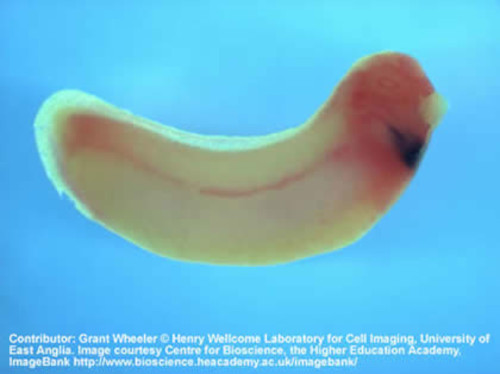Virtual Genetics Education Centre
Developmental genetics for higher education
Developmental genetics is the study of the way in which genes control the growth and development of an organism throughout its life-cycle. A newly fertilised egg cell - or zygote - contains a unique collection of genes that will control its development from a single cell into an embryo through patterns of differential gene expression in the process of embryogenesis.

An embryo of the African clawed frog (Xenopus laevis) treated to show the expression of two genes. Messenger RNA for a gene called Frizzled7 (stained red) is found in the head and in a line down the trunk of the embryo. The gene Nkx2.5 (dark blue) is expressed in the heart of the embryo.
Creating an organism from a single cell involves three processes:
- Cell division through mitosis.
- Cell differentiation through gene activation and inactivation.
- Morphogenesis - pattern formation - through the combined effects of cell division, cell differentiation and cell death.
Genes control patterns of cell division and cell death (apoptosis) in the developing embryo. Genes also control the differentiation of cells from an original totipotent state (able to make all cell types) through a pluripotent state (able to make some cells types, like stem cells) to their final destination as specific cell types or cell lineages (cell determination).
Cells differentiate into different types of cells because of differential patterns of gene expression. Genes may be activated or inactivated ('silenced') by regulation of the processes of transcription and translation. See Gene expression and regulation for more details.
Genes are activated by proteins called transcription factors, which bind to promoters at the start of the gene and regulate the process of transcription. Transcription factors are the products of other genes that, in turn, may have been activated by other transcription factors. This cascade of genes and transcription factors is initiated by control genes that are activated by autonomous, conditional or syncytial specification.
- Autonomous specification (especially common in invertebrates). Some chemicals and structures in the fertilised egg cell are inherited unevenly by subsequent cell populations. These cytoplasmic, or morphogenetic, determinants include RNA molecules, which code for transcription factors, as well as other proteins and organelles in the cytoplasm. Different concentrations of these factors in different cell populations cause different patterns of gene expression and subsequent cell differentiation.
- Conditional specification (found in all vertebrates and some invertebrates). Cells are differentiated by interactions with neighbouring cells. In some cases, cells, or groups of cells, in the developing embryo release proteins, including transcription factors. These morphogens act on the control genes of other cells, starting cascades of gene activation and inactivation. In some cases, the morphogens set up concentration gradients as they diffuse through the embryo, and the differentiation of cells is dependent on their position along the gradient.
- Syncytial specification. In many insects, cell differentiation is the result of interactions within cells, not between cells. Incomplete cell divisions after fertilization result in a cell containing many nuclei (a syncytium). Morphogens diffuse through the syncytium to set up concentration gradients that give cells information about their position: for example, along the anterior-posterior axis.
The basic three-dimensional layout of the body plan is established early in development: anterior and posterior, dorsal and ventral. A group of very similar genes - homeobox genes - have been found to regulate the process in fungi, plants and animals. Homeobox genes contain a specific nucleotide sequence, the homeobox region, which is about 180 nucleotides long. The homeobox produces a collection of transcription factor proteins (the homeodomain) that acts with other transcription factors to produce a cascade of gene activation and inactivation.
The homeobox genes responsible for segment identity during the formation of metazoan organisms are called homeotic genes, and mutations in these genes (homeotic mutations) can cause large disruptions to the body plan. For example, the Antennapedia mutation in the fruit fly (Drosophila melanogaster) causes legs - not antennae - to develop on the fly's head. In vertebrates, one particular subgroup of homeobox genes - the Hox genes - control the development of the limbs and other body parts.